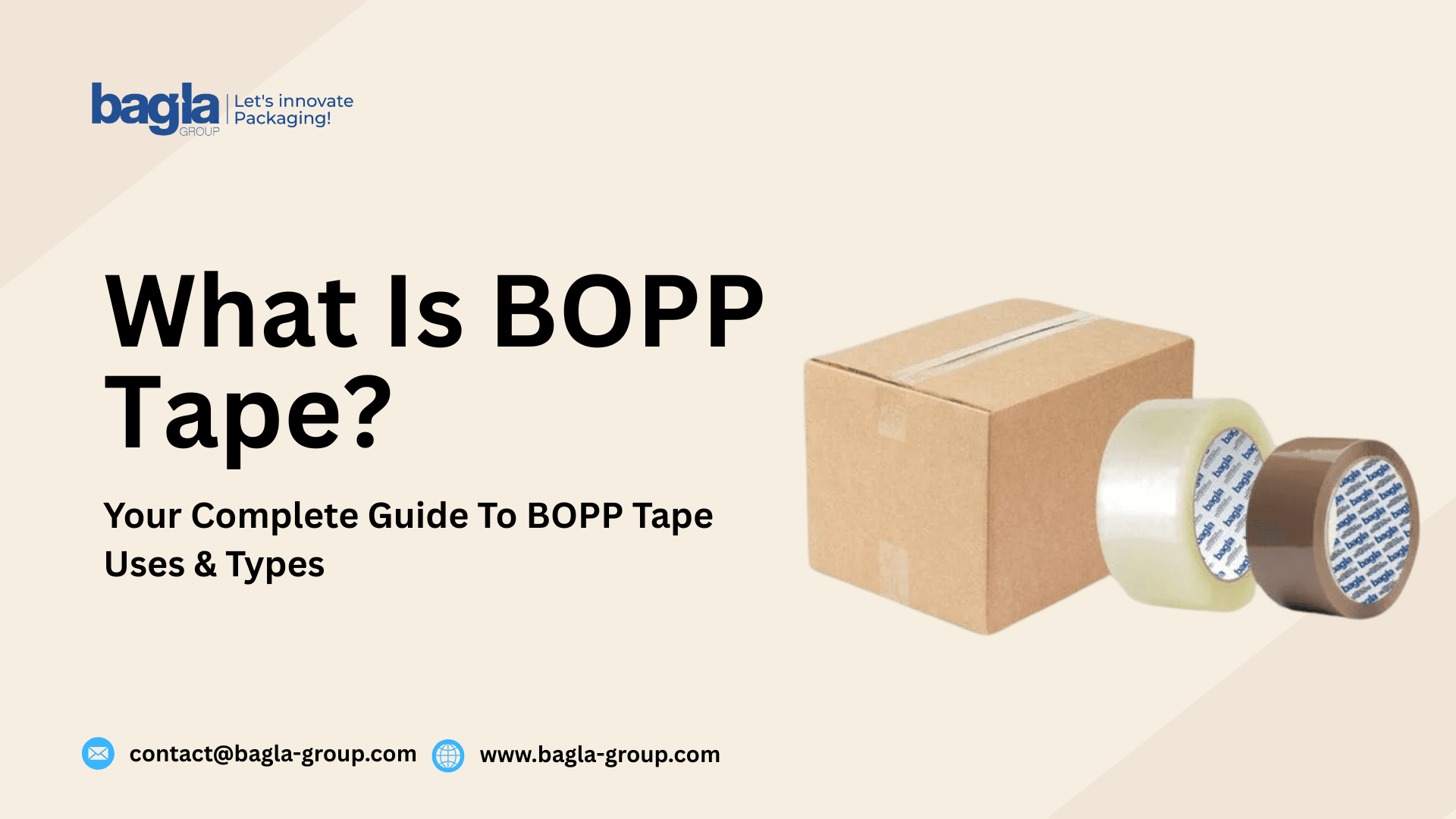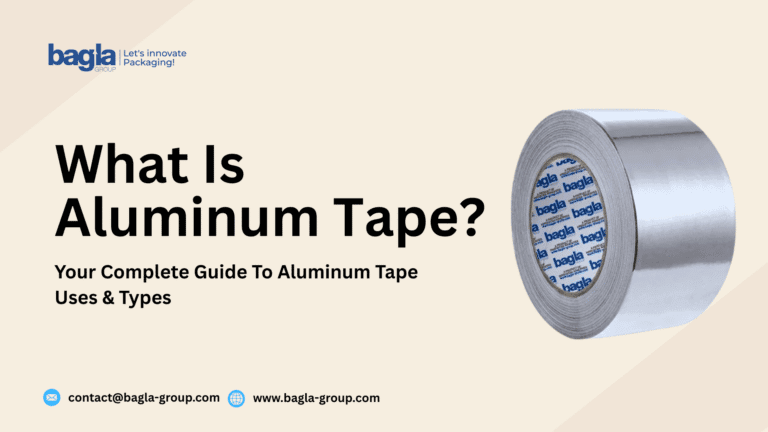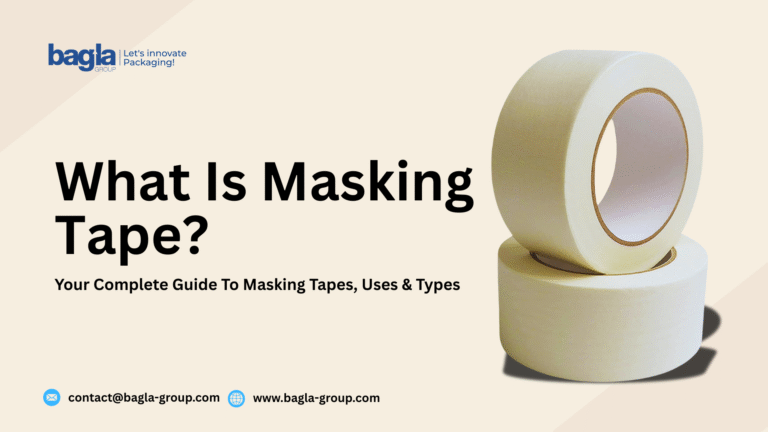Here we will discuss one type of adhesive tape that dominates warehouses, factories, and homes across the globe – BOPP Tape. It is one of the reliable choices for packaging, sealing, and shipping. The tape is known in the market for its strength, durability, and cost-effectiveness. BOPP tape becomes a good-to-go solution in multiple industries.
So, let’s break down the blog and explain to you what exactly BOPP tape is? What makes it so popular? And how is it different from other types of tapes?
What Does BOPP Stand For?
BOPP stands for Biaxially Oriented Polypropylene. For a better understanding, let’s break it down –
- Polypropylene (PP) – Polypropylene (PP) is a type of thermoplastic polymer known for being lightweight, flexible, and moisture-resistant.
- Biaxially Oriented – This means the film is stretched in two directions (machine direction and transverse direction) during production. This orientation process improves the film’s strength, clarity, and resistance.
In simple words, BOPP is a type of plastic film that’s been stretched both ways to make it tougher and more useful — especially as a base for adhesive tapes.
What is BOPP Tape?
BOPP tape is an adhesive tape that is made using a BOPP film as the base material. The tape is coated with pressure-sensitive adhesive (PSA) on the other side. Usually it is coated with acrylic-based, which allows the tape to stick firmly with just a little pressure.
It’s widely used for carton sealing, packaging, labeling, and bundling due to its –
- High tensile strength
- Resistance to moisture and chemicals
- Smooth surface
- Excellent clarity and printability
How is BOPP Tape Manufactured?
The process of making BOPP tape involves several key steps –
1. Film Production
The first step is that raw polypropylene granules are melted and extruded to create a thin sheet. This thin sheet then biaxially stretched — both longitudinally and transversely — to enhance its properties.
2. Adhesive Coating
The stretched BOPP film is coated with a layer of pressure-sensitive adhesive. This adhesive is typically water-based acrylic or hotmelt. The adhesive in BOPP tapes determines the tack, peel, and shear strength of the tape.
3. Slitting and Rewinding
The master roll of coated film is slit into smaller rolls according to required widths and lengths.
4. Packaging
The rolls are packed in boxes or shrink-wrapped and made ready for shipment.
Key Features of BOPP Tape
Here’s what makes BOPP tape a popular choice –
- High Strength – Excellent tensile and tear resistance
- Lightweight – Easy to use and reduces shipping weight
- Weather Resistant – Performs well in varying temperature and humidity
- Clear or Colored – Available in transparent, brown, or printed options
- Printable Surface – Can be customized with logos, warnings, or branding
- Long Shelf Life – Maintains adhesion and film integrity over time
Types of BOPP Tape
BOPP tapes come in different types based on application, adhesive, and color. Here are the most common types –
1. Transparent BOPP Tape
Used for general-purpose packaging where the content underneath needs to be visible. Often used in e-commerce, gift wrapping, and office settings.
2. Brown or Tan BOPP Tape
Common in logistics and carton sealing. Its color blends well with cardboard boxes and looks professional.
3. Colored BOPP Tape
Available in red, blue, green, yellow, etc., for color-coding and inventory identification.
4. Printed BOPP Tape
Custom printed with company logos, branding, instructions, or warning messages like “FRAGILE” or “HANDLE WITH CARE.”
5. Hotmelt BOPP Tape
Has hotmelt adhesive for fast, aggressive tack. Used in high-speed automated taping machines.
6. Acrylic BOPP Tape
Uses water-based BOPP acrylic tape adhesive. It offers better long-term adhesion, clarity, and UV resistance.
Common Applications of BOPP Tape
BOPP tape’s versatility makes it ideal across various sectors. Some key applications include –
1. Carton Sealing
Its primary use — sealing corrugated boxes during shipping and storage. Whether it’s retail or bulk logistics, BOPP tape ensures safe delivery.
2. Product Packaging
Used to seal packets, pouches, and gift boxes in industries like food, apparel, electronics, and FMCG.
3. Brand Promotion
Printed BOPP tapes are often used for marketing. Custom branding on tape makes the package look professional and adds visibility.
4. Warehouse & Inventory
Colored tapes help with product segregation, easy identification, and safety signage.
5. DIY and Stationery
Transparent variants are used in schools, offices, and homes for art, labeling, and bundling.
Advantages of BOPP Tape Over Other Tapes
Let’s see how BOPP tape compares to other common types of tape –
| Feature | BOPP Tape | Duct Tape | Masking Tape |
| Material | Biaxially oriented PP | Fabric + Rubber | Crepe paper + Rubber |
| Strength | High | Moderate | Low |
| Moisture Resistance | High | Medium-High | Low |
| Clarity/Printability | Excellent | Poor | Medium |
| Cost Efficiency | Very cost-effective | Expensive | Medium |
| Ideal Use | Packaging | Repair/Fabrication | Painting/Marking |
Clearly, for packaging and shipping, BOPP tape stands out.
Choosing the Right BOPP Tape
When selecting BOPP tape, consider the following factors –
1. Adhesive Type
- Acrylic – Long-lasting, UV-resistant, good for long storage
- Hotmelt – Strong initial tack, ideal for machine use
- Solvent – Used for extreme weather and dusty surfaces
2. Micron Thickness
Standard tape thickness ranges from 35 to 65 microns. More thickness = stronger grip and durability.
3. Width & Length
Most common sizes are –
- Width – 48mm, 60mm, 72mm
- Length – 50m, 65m, 100m, 1000m+ (for machine rolls)
4. Brand or Customization
For businesses, using branded printed tape boosts professionalism and brand recall.
BOPP Tape and Sustainability
As awareness about plastic waste grows, BOPP tapes are being evaluated for environmental impact. While BOPP itself is recyclable, the adhesive can make recycling difficult unless properly handled.
Eco-friendly alternatives include –
- BOPP tapes with water-based adhesives
- Biodegradable or paper-based tapes (for low-demand uses)
- Encouraging the collection and recycling of used tapes
Some manufacturers are now producing BOPP tapes with eco-conscious packaging and processes, helping reduce the carbon footprint.
Top Industries That Use BOPP Tape
- E-Commerce & Retail
- Sealing boxes for shipping, order branding, and returns
- Manufacturing
- Bundling, labeling, or securing components
- FMCG & Food
- Packaging for consumer products, groceries, and perishables
- Logistics & Warehousing
- Color coding, load securing, and inventory control
- Pharmaceutical & Healthcare
- Tamper-proof printed BOPP tapes for secure handling
Why BOPP Tape Makes That “Screeching Sound”?
Ever pulled a BOPP tape roll and heard that high-pitched sound?
That’s due to the tension between the adhesive and the polypropylene film. Some tapes come with “low noise” variants specially designed for quieter environments like offices or hospitals.
How to Store and Use BOPP Tape?
To enhance the performance of the BOPP tape, you must store it with proper precautions:
- Store in a cool, dry place (away from sunlight)
- Avoid stacking heavy items on rolls
- Use a tape dispenser or machine for smooth application
- Don’t apply on dusty, oily, or wet surfaces – it reduces adhesion
Conclusion
BOPP tapes a simple products but play a vital role in the modern supply chain. This product is mostly used for carton sealing and packaging. BOPP tape is a cost-effective, durable, and versatile choice. It is a smart, strong, and secure solution for running a business, working in a warehouse, or just needing something reliable for daily use.
For business and home purposes, we recommend that you choose the right type of base according to your needs. To make your packaging stand out in the market, don’t forget to choose branded or printed BOPP tape options.



